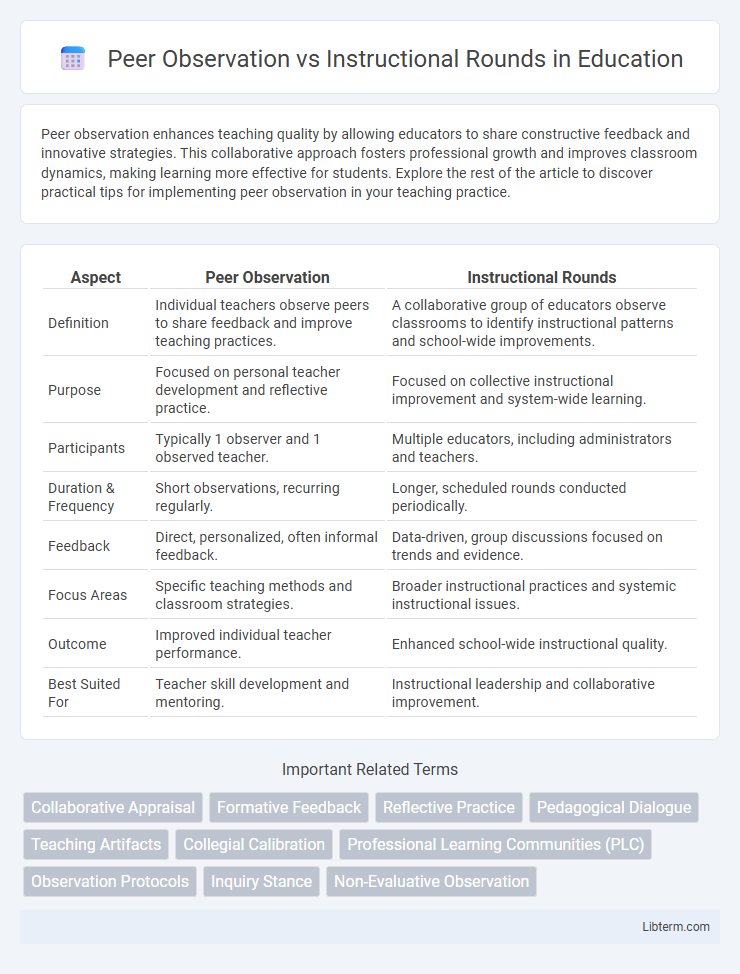Peer observation enhances teaching quality by allowing educators to share constructive feedback and innovative strategies. This collaborative approach fosters professional growth and improves classroom dynamics, making learning more effective for students. Explore the rest of the article to discover practical tips for implementing peer observation in your teaching practice.
Table of Comparison
| Aspect | Peer Observation | Instructional Rounds |
|---|---|---|
| Definition | Individual teachers observe peers to share feedback and improve teaching practices. | A collaborative group of educators observe classrooms to identify instructional patterns and school-wide improvements. |
| Purpose | Focused on personal teacher development and reflective practice. | Focused on collective instructional improvement and system-wide learning. |
| Participants | Typically 1 observer and 1 observed teacher. | Multiple educators, including administrators and teachers. |
| Duration & Frequency | Short observations, recurring regularly. | Longer, scheduled rounds conducted periodically. |
| Feedback | Direct, personalized, often informal feedback. | Data-driven, group discussions focused on trends and evidence. |
| Focus Areas | Specific teaching methods and classroom strategies. | Broader instructional practices and systemic instructional issues. |
| Outcome | Improved individual teacher performance. | Enhanced school-wide instructional quality. |
| Best Suited For | Teacher skill development and mentoring. | Instructional leadership and collaborative improvement. |
Understanding Peer Observation
Peer Observation involves educators observing each other's teaching practices to provide constructive feedback aimed at professional growth and improving instructional methods. This collaborative approach fosters reflective teaching, encourages sharing of effective strategies, and enhances classroom performance by focusing on specific pedagogical techniques. Understanding Peer Observation highlights its role in creating a supportive learning community that prioritizes continuous improvement and shared accountability among educators.
What Are Instructional Rounds?
Instructional rounds are a collaborative practice where educators observe classroom teaching to identify effective strategies and areas for improvement, focusing on student learning and instructional practices. Unlike peer observation, which typically involves one teacher observing another, instructional rounds engage a team of educators moving through multiple classrooms to collect evidence and discuss findings systematically. This process promotes shared expertise, data-driven decision-making, and continuous professional development to enhance overall instructional quality.
Key Differences Between Peer Observation and Instructional Rounds
Peer Observation centers on individual teacher evaluation through direct classroom visits, providing personalized feedback aimed at professional development. Instructional Rounds involve a collaborative team of educators observing multiple classrooms to identify systemic teaching practices and school-wide instructional trends. Unlike Peer Observation's one-to-one approach, Instructional Rounds emphasize collective inquiry and shared insights to improve overall educational quality.
Objectives and Goals of Each Approach
Peer Observation aims to enhance individual teaching practices through focused feedback and reflective dialogue, targeting specific pedagogical skills and classroom management techniques. Instructional Rounds focus on collaborative professional learning by examining broader patterns across multiple classrooms, promoting shared problem-solving to improve overall school-wide instructional quality. Both approaches strive to elevate teaching effectiveness but differ in scale and scope, with Peer Observation emphasizing personal growth and Instructional Rounds fostering systemic improvement.
Process and Structure: Step-by-Step Comparison
Peer Observation involves a structured process where teachers observe one another's lessons individually, followed by reflective feedback sessions aimed at improving instructional techniques. Instructional Rounds consist of a collaborative, multi-observer approach with teams cycling through classrooms to identify patterns in teaching practices and student learning, culminating in group discussions for systemic improvements. The key difference lies in Peer Observation's focus on personalized, dyadic feedback versus Instructional Rounds' collective analysis for broader school-wide instructional enhancements.
Role of Collaboration in Both Practices
Collaboration plays a central role in both Peer Observation and Instructional Rounds by fostering shared learning and reflective practice among educators. Peer Observation emphasizes one-on-one or small group feedback sessions, allowing teachers to exchange constructive insights and refine teaching strategies. Instructional Rounds involve collaborative walkthroughs with multiple educators analyzing classroom interactions collectively to identify best practices and promote continuous school-wide improvement.
Benefits of Peer Observation
Peer observation enhances teaching quality by providing personalized, real-time feedback that fosters reflective practice and professional growth among educators. It promotes a collaborative culture, enabling teachers to exchange effective strategies and improve classroom management techniques. This process directly impacts student outcomes by identifying areas for instructional improvement tailored to specific teaching styles and classroom dynamics.
Advantages of Instructional Rounds
Instructional rounds provide a structured, collaborative approach to improving teaching practices by allowing educators to observe multiple classrooms systematically, increasing the breadth and depth of collective insights. This method promotes a shared professional language, fostering targeted discussions that lead to actionable strategies and sustained school-wide improvement. The emphasis on group analysis and continuous feedback enhances instructional coherence and aligns teaching practices with overall educational goals.
Challenges and Limitations of Each Method
Peer observation often faces challenges such as observer bias and inconsistent feedback quality, which can hinder objective evaluation and professional growth. Instructional rounds involve logistical complexities, including coordinating schedules and managing diverse observer expertise, potentially limiting their frequency and effectiveness. Both methods may struggle with resistance from educators wary of judgment, impacting the authenticity of observed practices and subsequent improvements.
Choosing the Right Strategy for Professional Development
Peer observation fosters individualized feedback by allowing teachers to observe and reflect on each other's instructional practices, enhancing personal growth and targeted skill development. Instructional rounds involve collaborative team-based classroom visits that promote school-wide learning through shared evidence and collective analysis of teaching strategies. Selecting the appropriate professional development approach depends on goals such as personalized improvement with peer observation or systemic improvement and culture building with instructional rounds.
Peer Observation Infographic

 libterm.com
libterm.com